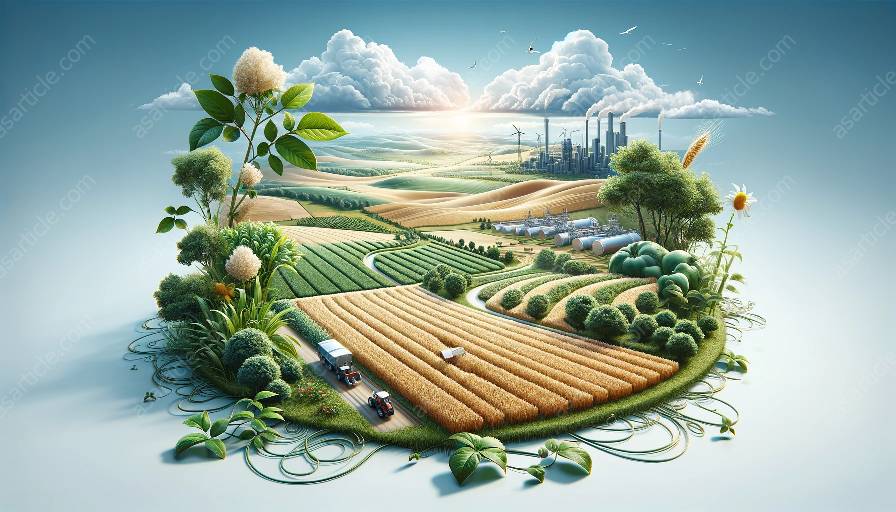As the world continues to seek sustainable solutions to meet its energy needs, bioenergy has emerged as a promising alternative. One important aspect of bioenergy production is the bioconversion of crop residues, which not only addresses the challenge of agricultural waste management but also contributes to advancements in agricultural sciences. This article delves into the methods, benefits, and significance of crop residue bioconversion, emphasizing its compatibility with bioenergy and agricultural waste management.
The Importance of Bioenergy and Agricultural Waste Management
Bioenergy, derived from biological sources, offers a renewable and environmentally friendly alternative to fossil fuels. It encompasses various forms of energy, such as biofuels, bioelectricity, and biogas, and has gained attention due to its potential for reducing greenhouse gas emissions and dependence on non-renewable resources.
Concurrently, agricultural activities generate significant amounts of organic waste, including crop residues such as straw, husks, stalks, and leaves. Addressing the management of agricultural waste is crucial for minimizing environmental impacts, promoting sustainable farming practices, and ensuring the efficient use of natural resources.
Understanding Crop Residue Bioconversion
Crop residue bioconversion involves the conversion of agricultural waste materials into bioenergy through biological, chemical, or thermochemical processes. These processes aim to harness the energy stored in the organic compounds of crop residues, thereby providing a valuable resource for bioenergy production. Some key methods of crop residue bioconversion include anaerobic digestion, fermentation, pyrolysis, and gasification.
1. Anaerobic Digestion
Anaerobic digestion utilizes microorganisms to break down crop residues in the absence of oxygen, resulting in the production of biogas, a renewable energy source composed primarily of methane and carbon dioxide. This method not only generates bioenergy but also produces digestate, a nutrient-rich organic fertilizer that can be utilized in agricultural practices.
2. Fermentation
Fermentation involves the conversion of crop residues into biofuels such as ethanol through the action of microorganisms, making it a valuable process for bioenergy production. Additionally, fermentation can yield other valuable by-products, such as organic acids and enzymes, with various industrial applications.
3. Pyrolysis
Pyrolysis is a thermochemical process that decomposes crop residues in the absence of oxygen, producing biochar, bio-oil, and syngas. These products can be utilized as soil amendments, renewable fuels, and feedstock for the synthesis of chemicals and materials, contributing to sustainable agricultural practices and bioenergy production.
4. Gasification
Gasification involves the conversion of crop residues into syngas, a mixture of carbon monoxide, hydrogen, and other gases, through partial oxidation at high temperatures. Syngas serves as a versatile precursor for the production of electricity, heat, and biofuels, showcasing the potential of crop residue bioconversion in enhancing energy security and reducing reliance on conventional fuels.
Bioenergy and Agricultural Waste Management Benefits
Crop residue bioconversion offers numerous benefits that extend beyond bioenergy production. By integrating bioconversion processes into agricultural waste management, several positive outcomes can be realized:
- Reduced Environmental Footprint: The conversion of crop residues into bioenergy reduces greenhouse gas emissions and diminishes the need for landfill disposal, mitigating environmental impact.
- Enhanced Soil Health: The application of digestate and biochar obtained from bioconversion processes improves soil fertility, structure, and nutrient retention, promoting sustainable agricultural practices.
- Energy Security: Bioenergy production from crop residues contributes to diversifying energy sources and reducing reliance on non-renewable fuels, thereby enhancing energy security.
- Value-Added Products: Bioconversion processes yield valuable by-products such as organic fertilizers, biofuels, and chemicals, creating economic opportunities and adding value to agricultural waste materials.
- Research and Innovation: Crop residue bioconversion stimulates advancements in agricultural sciences, bioenergy technology, and waste management practices, facilitating ongoing research and innovation in these fields.
Advancements in Agricultural Sciences
The integration of crop residue bioconversion into agricultural waste management contributes to the advancement of agricultural sciences in several ways:
- Biological Studies: Understanding the microbial processes involved in bioconversion enhances knowledge of microbiology, enzymology, and microbial ecology, leading to insights that benefit both agricultural and environmental research.
- Waste Valorization: Research and development in bioconversion technologies promote the valorization of agricultural waste, fostering interdisciplinary collaborations and innovations in bioprocessing, bioengineering, and biorefinery concepts.
- Sustainable Agriculture: The utilization of biochar, digestate, and other bioconversion products contributes to sustainable agricultural practices, aligning with the principles of agroecology and resource efficiency in farming systems.
- Policy and Regulation: The deployment of bioenergy and bioconversion strategies requires the formulation of supportive policies, standards, and regulations, driving advancements in agricultural policy, environmental governance, and waste management frameworks.
Conclusion
Crop residue bioconversion plays a vital role in bioenergy production and agricultural waste management, offering multifaceted benefits that contribute to sustainable agricultural practices and advancements in agricultural sciences. By harnessing the energy potential of crop residues through innovative bioconversion technologies, we can address the challenges of agricultural waste, promote renewable energy sources, and advance our understanding of agricultural and environmental sciences. This harmonious integration of bioenergy, waste management, and agricultural sciences serves as a testament to the potential of bioconversion in fostering sustainable and resilient agricultural systems globally.

